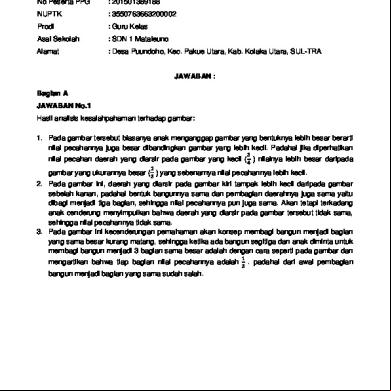Aggressive Periodontitis 52223
This document was ed by and they confirmed that they have the permission to share it. If you are author or own the copyright of this book, please report to us by using this report form. Report 2z6p3t
Overview 5o1f4z
& View Aggressive Periodontitis as PDF for free.
More details 6z3438
- Words: 408
- Pages: 27
DD 41 TAK RANUCH NGET RATTANA
Please turn on cell phones To Vibrate mode
Content Introduction Classification Genetic Diagnosis Treatment Reference
Introduction Periodontitis is the inflammation of the
periodontium which comprise of tissues ing the teeth in the oral cavity. Early onset periodontitis was the previous classification of aggressive periodontitis.
Anatomy of the Periodontium
Classification of Aggressive Periodontitis Localized aggressive periodontitis (LAP) Generalized aggressive periodontitis (GAP)
Changes in junctional epithelium
Proliferates along the root surface (finger – like projections)
Coronal portion detaches form the root
Due to bacterial enzymes and physical forces exerted by them
Apical portion of junctional epithelium migrates
Replaced by pocket epithelium
Localized Aggressive Periodontitis First molar and/ or incisors Low clinical inflammation Poor inflammatory response Mobility and migration of first molar and
incisors most common on the maxillary (Diastema).
Neutrophils
Chemotatic Factor
Macrophage
-Lysosomal enzymes collagenase - PE2
MatrixMetaloProteina se
Localized Aggressive Periodontitis Symptom of LAP Root surface sensitivity Deep dull radiating pain Periodontal abscess formation Regional lymph node enlargement. Patient serum is be found Ig G2. The high risks of LAP is seen mostly between
puberty and 20 year of age. (Female)
Localized Aggressive Periodontitis Aetiology of LAP Plaque (primary): A. actinomycetemcomitans (Aggregatibacter BDJ), P. gingivalis, P. intermidia. Diabetes Trauma occlusion Ig G2 type which is specific to antigens of
A. actinomycetemcomitans.
Generalized Aggressive Periodontitis Previously classified as Generalized Juvenile
periodontitis and Rapid Progressive periodontitits. Characterized by generalized interproximal attachment loss affecting at least 3 permanent teeth. Highly inflammatory response Highly bone and attachment loss
Generalized Aggressive Periodontitis Aetiology of GAP Plaque: A. actinomycetemcomitans, P. gingivalis, Baceroids forsuthus. Invading bacteria: Capnocytophaga sputigena, Mycoplasama sub-species and Spirochetes.
Generalized Aggressive Periodontitis Symptom: Acute inflammation tissues Spontaneous bleeding Deep pocket
GAP affects persons between puberty and 35
year old.
Genetic Factors Many researchers have suggested that, a major
gene play a role in Aggressive periodontal disease, which is transmitted by the autosomal dominant mode of inheritance. Approximately 75% of LAP has dyfunctional neutrophils. (Chemotatic ) Complement component C5a Leukotriene B4 40% deficiency in glycoprotein (GP110) on
neutrophil surface.
Diagnosis Clinical diagnosis X – ray Test of mobility Serological test (A. actinomycetecomitans)
Treatment Remove plaque and calculus Extraction Oral hygiene Scaling (mild) Root planning (moderate) Surgery (severe)
Medication Tetracycline hydrochloride 250mg qid at least
a week Doxycyline Chlorhexidine rinse should be prescribed Such case: Amoxicillin + Metronidazole
Reference www.Scribd.com www.Pubmed.com Essential Clinical Periondontology and
Periodontologic (Shantipriya Reddy 2006) Periodontology 10th edition (2008)
Please turn on cell phones To Vibrate mode
Content Introduction Classification Genetic Diagnosis Treatment Reference
Introduction Periodontitis is the inflammation of the
periodontium which comprise of tissues ing the teeth in the oral cavity. Early onset periodontitis was the previous classification of aggressive periodontitis.
Anatomy of the Periodontium
Classification of Aggressive Periodontitis Localized aggressive periodontitis (LAP) Generalized aggressive periodontitis (GAP)
Changes in junctional epithelium
Proliferates along the root surface (finger – like projections)
Coronal portion detaches form the root
Due to bacterial enzymes and physical forces exerted by them
Apical portion of junctional epithelium migrates
Replaced by pocket epithelium
Localized Aggressive Periodontitis First molar and/ or incisors Low clinical inflammation Poor inflammatory response Mobility and migration of first molar and
incisors most common on the maxillary (Diastema).
Neutrophils
Chemotatic Factor
Macrophage
-Lysosomal enzymes collagenase - PE2
MatrixMetaloProteina se
Localized Aggressive Periodontitis Symptom of LAP Root surface sensitivity Deep dull radiating pain Periodontal abscess formation Regional lymph node enlargement. Patient serum is be found Ig G2. The high risks of LAP is seen mostly between
puberty and 20 year of age. (Female)
Localized Aggressive Periodontitis Aetiology of LAP Plaque (primary): A. actinomycetemcomitans (Aggregatibacter BDJ), P. gingivalis, P. intermidia. Diabetes Trauma occlusion Ig G2 type which is specific to antigens of
A. actinomycetemcomitans.
Generalized Aggressive Periodontitis Previously classified as Generalized Juvenile
periodontitis and Rapid Progressive periodontitits. Characterized by generalized interproximal attachment loss affecting at least 3 permanent teeth. Highly inflammatory response Highly bone and attachment loss
Generalized Aggressive Periodontitis Aetiology of GAP Plaque: A. actinomycetemcomitans, P. gingivalis, Baceroids forsuthus. Invading bacteria: Capnocytophaga sputigena, Mycoplasama sub-species and Spirochetes.
Generalized Aggressive Periodontitis Symptom: Acute inflammation tissues Spontaneous bleeding Deep pocket
GAP affects persons between puberty and 35
year old.
Genetic Factors Many researchers have suggested that, a major
gene play a role in Aggressive periodontal disease, which is transmitted by the autosomal dominant mode of inheritance. Approximately 75% of LAP has dyfunctional neutrophils. (Chemotatic ) Complement component C5a Leukotriene B4 40% deficiency in glycoprotein (GP110) on
neutrophil surface.
Diagnosis Clinical diagnosis X – ray Test of mobility Serological test (A. actinomycetecomitans)
Treatment Remove plaque and calculus Extraction Oral hygiene Scaling (mild) Root planning (moderate) Surgery (severe)
Medication Tetracycline hydrochloride 250mg qid at least
a week Doxycyline Chlorhexidine rinse should be prescribed Such case: Amoxicillin + Metronidazole
Reference www.Scribd.com www.Pubmed.com Essential Clinical Periondontology and
Periodontologic (Shantipriya Reddy 2006) Periodontology 10th edition (2008)










